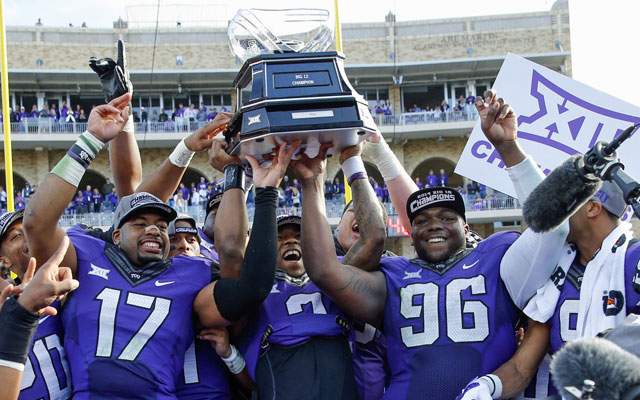The College Football Playoff Selection Committee has spoken loudly to the Big 12: Thirteen games are better than 12.
As the one major conference left out of the first CFP, the Big 12 will at least explore adding a conference championship game (that 13th game). The discussion starts in earnest this week in Phoenix, where nearly 40 percent of FBS schools will stage their spring meetings (MAC, Mountain West, Pac-12, Big 12).
"What we heard is that if we don't go to a championship game we're at a disadvantage," Big 12 commissioner Bob Bowlsby told reporters last week in Dallas for the CFP spring meetings.
Except that's not quite the interpretation CFP officials gave after hearing Bowlsby's comments. CBSSports.com talked to several officials who stressed that a 13th game mattered last season with Ohio State beating Wisconsin in the Big Ten title game. More specifically, the score -- 59-0 -- was the biggest determining factor.
The victory margin was the second-largest among the 56 conference title games played by Power 5 schools dating back to 1992. Plus, the Big 12 was a couple of upsets away from having two teams in the playoff (TCU, Baylor) without playing that league championship game.
So is the league overreacting?
One person close to the discussions told CBSSports.com, "Willing to bet the conference title game hurts the Big 12 more often than it helps."
A case can be made.
• The Big 12 would be diving back into an extra game full of uncertainty. The league staged a conference title game from 1996-2010 until conference realignment shrunk the conference to 10 teams. Since then, Big 12 teams have narrowly missed national championship berths twice in four years (Oklahoma State, 2011 BCS; TCU-Baylor, 2014 CFP).
But according to research by CBSSports.com, the point-spread favorite in conference title games has been upset almost a third of the time (17 in 56 total games -- or 30.3 percent among Power 5 conferences from 1992-2014).
Four times in 15 games (27 percent) the Big 12 favorite was beaten. While that percentage is smack in the middle among the Power 5, it's hard to judge because of sample sizes. The Pac-12 and Big Ten have each played only four conference champ games. The SEC has played 23.
More telling: Six times a Big 12 underdog either covered or won outright, an important consideration now with a human committee picking playoff teams.
• Among the Power 5, the Big 12 and SEC have lost the most national championship contenders (three) due to upsets in those conference title games.
Again, there is the issue of that sample size. The SEC lost those three contenders over 23 years while winning 11 national championships from 1992-2014, including seven in a row from 2006-2012.
No. 3 Nebraska (1996), No. 3 Kansas State (1998) and No. 1 Missouri (2007) all lost potential shots at Big 12 national championships due to upsets.
Texas set the tone with a shocking 37-27 win over the Huskers in '96. Two years later, Kansas State was 10 minutes away from a berth in the first BCS title game before losing to Texas A&M in overtime.
Missouri was tied at halftime with Oklahoma 17-17 of the '07 game before losing by three touchdowns.
• Only 22 teams from the current Power 5 have won conference championship games (out of 65 schools). Of those 22, 10 have won national championships since 1992. Two of those 10 (Oklahoma, Texas) play in the current Big 12.
• In this age of deregulation, the Big 12 may have a huge advantage. Along with the ACC, the league is sponsoring NCAA legislation that would do away with the NCAA rule that states conferences must have two divisions of at least six teams to stage a conference championship game.
On the surface, that would allow the Big 12 to split into five-team divisions. But deregulation would also allow leagues to choose their championship participants virtually any way they wish. That could conceivably mean the two "best" teams.
Forget division winners for the moment. Leagues could use any metric -- conference winning percentage, ranking, etc. The ACC could play as one 14-team league. No more danger of an 8-4 Duke upsetting an undefeated Florida State.
The Mountain West has caught on. In Phoenix this week, the MWC will consider using the format in 2016, when deregulation is expected to take effect.
As for the Big 12, the "best teams" format would have meant a TCU-Baylor rematch in 2014. Would the winner have had enough juice to beat out Ohio State?
Hard to say, but the Big 12 keeps harping about how it has the only true round-robin schedule. All the members play each other. One True Champion, and all that.
A new Big 12 championship game would be a rematch anyway, so why not pair the two "best" teams? Such games in the 10-team era would have been: No. 3 Oklahoma State vs. No. 11 Kansas State (2011); No. 6 Kansas State vs. No. 11 Oklahoma (2012); No. 9 Baylor vs. No. 17 Oklahoma (2013); No. 6 Baylor vs. No. 3 TCU (2014). Rankings are BCS in 2011-13 and CFP in 2014 going into the final week of the season.
Deregulation could be a game-changer nationwide. According to that CBSSports.com research, almost two-thirds of all Power 5 championship games haven't matched the two "best" teams (66.1 percent).
"Best" is generally defined as a league's two highest-ranked teams. Twelve times in 15 years, the Big 12 didn't match its two best teams. That rate was the highest among the Power 5.
• The fatal flaw of a four-team playoff still exists in the inherent, impossible math problem. Five doesn't go into four.
There are only four playoff spots for the five major conferences (ACC, SEC, Big 12, Pac-12, Big Ten).
The CFP fathers have tried not to change anything about the year-old system. They keep referring back to how the BCS evolved from year to year, eroding public trust as they tried to plug an increasingly leaky dam.
Stability was the key. CFP selection committee chairman Jeff Long's assertion that a 13th game is the difference maker -- at least last season -- just about changes the entire enterprise. The playoff is supposed to be populated by the four best teams judged by the selection committee. The Big 12 has taken that to mean only conference championship-game winners need apply.
The SEC's rise to power was built on the fact it largely avoided upsets in those league title games. It has played to the Big Ten's advantage having three upsets in four years. Ask Ohio State last season.
Meanwhile, Notre Dame AD Jack Swarbrick said he had no interest in adding an extra game as an independent.
"In the end our regular season is better than anybody else's regular season," Swarbrick told reporters this week.
Who's right about the conference championship game?
"I just don't understand how people who follow the sport, whether it's the media or administration, don't understand how clearly it cuts both ways," Big Ten commissioner Jim Delany told ESPN.com last week.
History of Power Five Conference Championship Games (1992-2014)
| Upsets (favorite lost ouright) | ||
| Conference | Frequency | |
| ACC | 3 times in 10 years | 30 percent |
| Big Ten | 3 times in 4 years | 75 percent |
| Big 12 | 4 times in 15 years | 26.6 percent |
| Pac-12 | 1 time in 4 years | 25 percent |
| SEC | 6 times in 23 years | 26.1 percent |
| TOTAL | 17 times in 56 games | 30.3 percent |
| Underdog (covered or won outright) | ||
| Conference | Frequency | |
| ACC | 5 times in 10 years | 50 percent |
| Big Ten | 4 times in 4 years | 100 percent |
| Big 12 | 6 times in 15 years | 40 percent |
| Pac-12 | 3 times in 4 years | 75 percent |
| SEC | 10 times in 23 games | 43.5 percent |
| TOTAL | 28 times in 56 games | 50 percent |
| Lost title contender (top 5 team lost in title game) | ||
| Conference | Frequency | |
| ACC | 2 times in 10 games | 20 percent |
| Big Ten | 1 time in 4 years | 25 percent |
| Big 12 | 3 times in 15 years | 20 percent |
| Pac-12 | 0 times in 4 years | 0 percent |
| SEC | 3 times in 23 years | 13 percent |
| TOTAL | 9 times in 56 games | 16.1 percent |
| Title boost (title-game winner played for national crown)+ | ||
| Conference | Frequency | |
| ACC | 2 times in 10 games | 20 percent |
| Big Ten | 1 time in 4 years | 25 percent |
| Big 12 | 4 times in 15 years | 26.6 percent^ |
| Pac-12 | 1 time in 4 years | 25 percent |
| SEC | 13 times in 23 years | 56.5 percent |
| TOTAL | 21 times in 56 games | 37.5 percent |
| Best teams did not meet (league’s highest-ranked teams didn’t square off)* | ||
| Conference | Frequency | |
| ACC | 5 times in 10 years | 50 percent |
| Big Ten | 3 times in 4 years | 75 percent |
| Big 12 | 12 times in 15 years | 80 percent |
| Pac-12 | 3 times in 4 years | 75 percent |
| SEC | 14 times in 23 years | 60.9 percent |
| TOTAL | 37 times in 56 games | 66.1 percent |
Notes:
+ Includes bowl, BCS and CFP eras
^ Oklahoma lost the 2003 Big 12 game to Kansas State 35-7 but still played for the BCS national championship.
* Generally, in the title game. Some conference records and head-to-head results were taken into account.
















